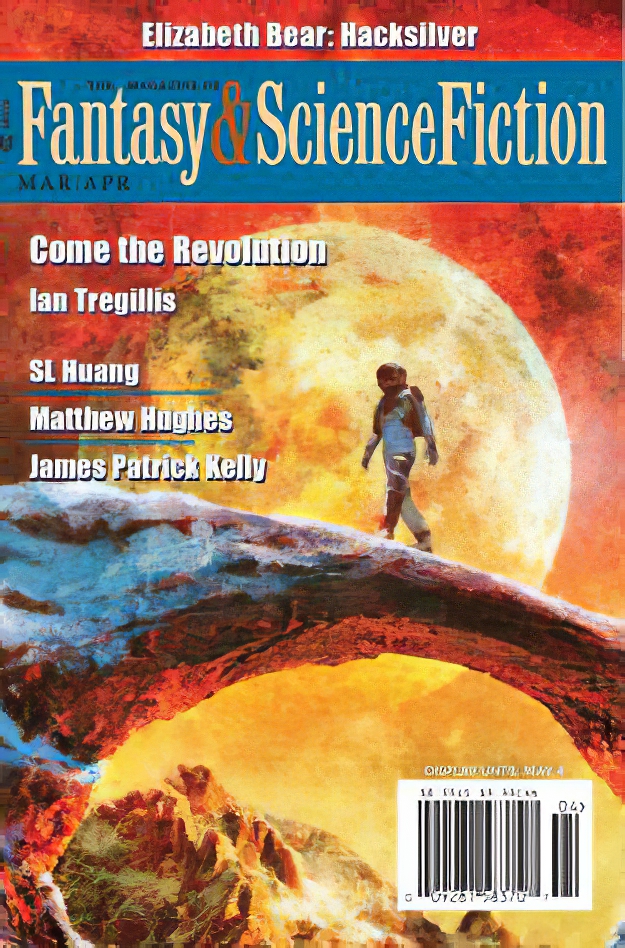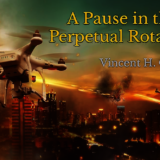
In an attempt to make up for being late with last week’s column (okay, the column wasn’t late but the review certainly was), I’m skipping away from my “near-perfect” movie thread to review the current issue of The Magazine of Fantasy and Science Fiction (F&SF). You can see all of the non-fiction written portions of the magazine at SF Site (click name for link to current issue). The cover this issue (Figure 1) is by Mondolithic Studios. In my Amazing Stories® columns, I review the fiction and poetry (if any). The non-fiction writing includes book reviews by Charles de Lint and Elizabeth Hand (who just had a birthday—happy birthday, Liz!); a “shiny” film review by David J. Skal; a science column by Jerry Oltion; and a “Curiosities” column by Graham Andrews. The fiction and poems are as follows:
NOVELLAS
Come the Revolution – Ian Tregillis
NOVELETS
Kikelomo Ultrasheen – Dare Segun Falowo
The Last Legend – Matthew Hughes
Hacksilver – Elizabeth Bear
Death on the Nefertem Express – Brian Trent
SHORT STORIES
The Million-Mile Sniper – SL Huang
Red Sword of the Celiac – John Possidente
Say You’re Sorry – Amman Sabet
A Solitary Crane Circles Cold Mountain – Gregor Hartmann
A Feast of Butterflies – Amanda Hollander
Hungry Is the Earth – William Ledbetter
The Man I Love – James Patrick Kelly
POEMS
To My Shipmates at Journey’s End – Lauren McBride
4 Vesta – Deborah L. Davitt
I’ll review these at random as the whim decrees. I hope that, because this magazine contains fourteen stories and poems, you don’t find this review TLDR, as they say (Too Long, Didn’t Read). I feel compelled—a geas, if you will—to review every story and poem, however, or I feel I’ll be cheating you, the reader. So let’s go, starting with “Red Sword of the Celiac” by John Possidente, which presents as a book review: Red Sword of the Celiac by P. Warden Accipit, Obscurantist Press, 2019. As it’s meant to, the review reveals as much about the reviewer as the book. (Also, I believe the author’s name is meant to echo accipiter, which is a kind of hawk.) Anyway, this book, “Red Sword of the Celiac” (pronounced “chell-ee-ack” rather than “see-lee-ack” according to the review) is, according to the publisher or author’s agent, the long-awaited capstone to the Celiac Saga. This review is full of references—slightly bent—to real-world things, such as “Gnoll Press.” (If you’re younger, you may not be familiar with the long-dead Gnome Press.) See how many you can find. The reviewer (unnamed), who has been given an ARC (Advance Reading Copy) of Accipit’s last book (he’s been dead for a few years), does something I try not to do: that is, reveals the endings of the books he reviews. Although I’m kind of weird in that “spoilers” don’t bother me, I know they bother a lot of people, so I try not to do them. You might find this story funny, even if you’re not a reviewer. I certainly do.
Hey, let’s do a poem next! How about “4 Vesta,” by Deborah L. Davitt? It’s about a mountain in the center of the impact crater, Rheasilvia, on Vesta, which as you probably already know, is one of the four asteroids in the Belt which can be sometimes seen from Earth. According to the poem, the mountain, which has no name, is the tallest in the solar system, being 14 miles from base to peak. Well, maybe it’s the tallest non-volcanic one, because I’m told by Wikipedia that Olympus Mons (on Mars, natch) is 16 miles tall. Anyway, the poem’s about building domes and such; even saving nearly-extinct animals. (Wonder if we can be saved before we go extinct?) Nicely written.
Now on to “A Feast of Butterflies,” by Amanda Hollander. It’s a fable of sorts, set in what could be Meso- or South America, near some mountains. A constable, chafing in an uncomfortable uniform in the summer heat is sent up the mountain to a village where several young boys have recently gone missing; one of them is the grandson of the local Judge, the man who sent the constable, willy-nilly. There is one suspect, a strange girl that the villagers have attempted to propitiate by leaving offerings of fruit, flowers, birds, but she ignores them all and mostly stays in her hut, weaving who knows what on her loom. The constable’s predecessor investigated the death of a different young boy, brother of this young woman, both children of the village’s best weaver, now deceased. She is said to be evil, and she eats butterflies. An odd little fable about abuse, retribution, and metamorphosis. Lyrically written. Nice.
SL Huang’s “The Million-Mile Sniper” is science fiction by definition, though it’s highly unlikely SF, in my opinion. The kinds of calculations involved would probably be impossible for the smartest computer or AI. What am I talking about? Well, Huang herself is a gun expert, reputedly extremely accurate, and she’s written a story about a future sniper who can plan months ahead at interplanetary distances. Depending on how you feel about violence, it can either be a fun story or a cautionary tale. Me, I have nothing against guns in the right context, so I found it fun.
“Hungry is the Earth” by William Ledbetter is an alien invasion story and a story of human devotion. The spider-dogs came to Earth by the millions, bringing their berry plants that killed Earthly vegetables and replaced them with more alien berry plants. Earth’s armies killed them by the millions, and they came until we had nothing left to kill them with. People who ate the berries died horribly. Isabella had promised her father before he left to always watch after her ten-year-old half brother Otto, but now Otto was deathly ill. How was all this going to end? I liked this one pretty well.
Matthew Hughes has appeared in F&SF many times with tales of Raffalon and Baldemar, but “The Last Legend” is a standalone not related to those stories. It, however, shares a certain wry sense of humour/irony with them. Matt has become one of the premier Canadian SF/F writers over the last few years; this story is as good a piece of fable-making as I have read recently. In it, a young man named Ardal, is raised on legends by his mother, who read to him constantly from a book of them. After his parents die in a tragic ferry accident, Ardal is given into the “care” of his uncle, a brutish and drunken man, who apprentices him to a fuller, sabotaging what was supposed to become a career in the law. (A fuller is an instrumental person in dyeing cloth; his apprentices spend much of their time calf-deep in human urine, which is used to ret, or set the dye.) How Ardal escapes this less-than-ideal future is the rest of the story, which I will leave you to discover for yourself. If you like fables and fairytales (absent actual fairies), you will definitely enjoy this one.
“Say You’re Sorry,” by Amman Sabet, is kind of based on how New Yorkers behave—at least, according to media; I haven’t been to NY since I was a kid, so have little first-hand experience. “I’m Sorry” isn’t something that comes easily, it seems, to them. Written by someone who knows, this is a little… what would I call it? A morality play sort of thing? (No, it’s not a play, it’s a story, but still….) Bellamy Green is the protagonist, and maybe he learns a bit about how to be nicer and less self-involved. Wry, and just a bit nasty, this isn’t the kind of story you see every day. I liked it!
Dare Segun Falowo’s “Kikelomo Ultrasheen” is a story from an entirely different tradition; the author’s from Nigeria, and just from reading it you can immerse yourself in African hair-weaving tradition. As a white boy from America, what did I know about cornrows? Damn little, the answer is. I always thought “a cornrow is a cornrow is a cornrow,” not even suspecting there were various kinds. And from this story we learn that some are even magical. Kikelomo (it means “caring is for the child”) is the protagonist; she is a hairdresser who has learned her trade at her mother’s knee. But some women are marked from birth, and Kikelomo is one. She has been marked by Onidiri, and she has been given a task: to heal people who have been cursed. A very strange, interesting story from a different perspective from those most of us are used to. (And some of it dovetails with other African things I’ve read).
James Patrick Kelly’s “The Man I Love” may seem like something you’ve seen before, because it’s set in a bar. But then, gazillions of F/SF stories are set in bars, aren’t they? From Dean Wesley Smith’s “Jesus Tended Bar” to Spider Robinson’s “Callahan’s Bar” stories, we love our bars. And it’s a ghost story, and we love our ghost stories too; this story about the Happy Valley Bar (only open on Mondays) is actually one with a happy ending. And it has Helen Forrest and Lena Horne both singing “The Man I Love.” What’s not to like?
Let’s do the issue’s other poem: “To My Shipmates at Journey’s End,” by Lauren McBride. It’s a three-stanza non-rhyming poem about astro-oceanography. It’s somewhat evocative, and it worked, I think.
“Come the Revolution,” by Ian Tregillis, is the longest story in the magazine. It’s set in a world he’s already written three books about; one similar to ours in the seventeeth or eighteenth century, and in which clockwork robots are animated by magic. “Geasa”—or magic compulsions—run the “Clakkers,” or so they’re named for the noises their mechanical bodies make. This story, like the HBO TV show Westworld, delves into that uncomfortable area where we must examine whether our purpose-built servants, whether they be flesh-and-blood androids, or clockwork robots, have minds and/or “souls” and probably shouldn’t be doomed to a life (or semi-life) of servitude. They speak the human language (which is probably Dutch), to be of use to their owners.
But the Clakkers, like the androids of Westworld, chafe under their involuntary servitude. Forbidden, by their geasa, to even talk any kind of sedition openly, they have developed their own secret language of spring, gear, and lever noises that pass for simple operational mechanical sounds, and the protagonist—a Clakker “herself”—not only learns this mechanical language, but becomes expert in its use. But, like Maeve in Westworld, an unintended accident releases her (called “Queen Mab,” after the Shakespearean fairy queen) from all geasa. A beautifully-written story.
“A Solitary Crane Circles Cold Mountain,” by Gregor Hartmann, envisions a future Earth where a clash of cultures has occurred in the past (the “Cloud Wars”), and the old “Machinist” culture is defeated. The new, worldwide, Gaia society seeks to heal the world and instill bioethics as a cultural norm. It sounds, rather, more like China during the Cultural Revolution: two warring groups, Eternal Typhoon and Tusunami Brigade clash frequently in their desire to root out Machinist remnants; “Remediation” is the central purpose of this culture. Lili is a sociolophysicist, working on the last remnant of Machinist culture—an asteroid at the L5 position, which will be a generation ship designed to take 400 years to get to the new Earth, a rocky world about the size of Earth (now called only Gaia) itself, which is being Terraformed by little robots sent via lightsail. The terraforming should be complete by the time the colonists get there.
Lili, working for The Foundation, is running computer simulations, trying to create a society for the asteroid that will not break down during the 400-year voyage; simulation after simulation fails, and Victor, who is investigating the Foundation—to see if this last relic of Machinist thinking should continue—is not-so-subtly wooing Lili. I, personally, enjoyed the story but find these sorts of society frightening. It’s the thinking behind such people as Mao Zedong, which assumes that people serve society—little better than ants—instead of the other way around. Such societies—look at China for an example (and the society of this story is based on that country); there is always a little ruling clique at the top, despite all the fancy talk about how everyone is equal. Some are always more equal than others. Well done, Mr. Hartmann!
Elizabeth Bear’s “Hacksilver” is set in some mythical Iceland in an earlier time. Continuing the issue’s theme of fables, this could well have been a Grimm fairy tale, although it partakes a little bit of Jason’s encouter with Polyphemus, the cyclops. Auga Agusson, called “Hacksilver” by his Viking comrades—hacksilver consists of fragments of cut and bent silver items that were used as bullion or as currency by weight—has returned home to his brother’s farm. When his parents died, his brother, as the elder, refused to share, so Auga went viking as a way to earn a living. He returns to find his brother’s farm in the hands of a neighbour, Eiðr Einarsson, and his brother and family gone to exile to repay a blood debt. He is seized by the townsfolk because his brother had apparently killed Eiðr’s wife and children, and the blood debt hadn’t been repaid. Hacksilver is beaten and his horse and possessions claimed by Eiðr; he is then exiled to the mountain, coatless and horseless, there to probably die in the cold. But Hacksilver is part witch, and has used what little magic he has to to give himself luck prior to coming home. Like all of Bear’s writing, it’s well done and evokes an earlier time and place.
“Death on the Nefertem Express,” by Brian Trent, is meant to echo Agatha Christie’s “Murder on the Orient Express.” (According to the story’s blurb, Dame Christie published a few fantasy stories in F&SF back in the ‘fifties.) Nefertem is a planet, and the Nefertem Express is a train that continually moves westward ahead of the sunrise. (If you’ve seen The Chronicles of Riddick, referenced in my column of March 6, you’ll know that the sun on some planets is too hot to be bearable. Nefertem is such a planet; if the train gets caught by the sunrise, it and all its contents (including crew and passengers) will be burnt to a crisp. The Nefertem’s shakedown voyage is likely to be its last, as someone has sabotaged the engine by stealing both a crucial part and its backup. Only former pirate Jolene Fort is both the prime suspect and the person most likely to solve the theft and save everyone’s lives. And in true Christie fashion, with a little humourous twist at the very end, this story plays out. Enjoyable!
Any comments? If you have any comments, you can put ‘em here or on Facebook, or even by email (stevefah at hotmail dot com). Every comment is welcome! (Doesn’t have to be approving, but keep it polite, okay?) My opinion is, as always, my own, and doesn’t necessarily reflect the views of Amazing Stories or its owner, editor, publisher or other columnists. See you next time!











On the premise of “The Million-Mile Sniper”–it’s not the calculations that are hard to believe, but that the velocity of a material projectile could be made so exact. Even a light-beam would be slowed and refracted by a planetary atmosphere in unexpected ways.
Unless it were a laser pulse to a target on an airless asteroid? We know the speed of light to 0.02 parts per billion–that’s about an inch in a million miles–so that could almost work. But it’s still hard to imagine an optic that would, over such distance, give a beam so tight as to pick out one person in a crowd.
“Hungry is the Earth” and “they came until we had nothing left to kill them with”: unlike guns, swords and spears keep on killing so long as there are wielders behind them who don’t mind getting up close and personal. That’s been enough to wipe out plenty of peoples in the past.
Hair-weaving in contemporary Africa is an important medium for political statement.
“Death on the Nefertem Express” seems to present a more believable excuse for a circumnavigational train than did Snowpiercer.
Hi, Graham–
The actual snipe was a projectile in airless space. Assuming no “space dust,” I suppose it’s possible to know the trajectories of everything in a given area of space for a given amount of time, but still…
I agree about Snowpiercer. I have a problem with “SF” that’s entirely improbable. That one was for me.